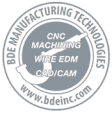Posted On: November 5, 2019
Computer Numerical Control (CNC) machining has gained popularity in the last few decades, owing to several advantages offered by them. Like any other computer-driven application, CNC machines utilize software to drive their functions. The software is known as CAD-CAM, which stands for Computer-Aided Design (CAD) and Computer-Aided Manufacturing (CAM). Owing to their beneficial features, CAD-CAM has become an integral part of CNC machine shops across the globe. How do these software applications work? How they are transforming the CNC machining industry? Read the post to know answers.
A Brief Introduction to CAD-CAM Software
Before discussing the benefits of CAD-CAM software, let’s understand their functioning.
- CAD:
This involves the creation of computer models based on specific geometric models. These geometric models can be seen on the computer monitor as a three-dimensional representation. These models can be easily altered by changing parameters. These systems allow designers to see objects under a variety of representations. Also, they can test these computer models by simulating them in real-world conditions.
- CAM:
These software applications are designed to control and automate machines.
How CAD-CAM Systems Are Driving the CNC Machining Industry?
Over the years, CNC machine shops have realized the following advantages by investing in CAD-CAM software.
- Rapid Prototyping:
This is one of the major benefits assured by the CAM. The designers can easily construct prototypes during the designing phase. These prototypes can be employed for testing various design aspects.
- Flexibility of Designing:
CAD-CAM software assures lots of design flexibility. As it allows users to make particular design changes easily. Before this software, design changes were made by draftsperson who would take days to redraw the design, thereby stretching the designing time. However, CAD-CAM software applications enable users to make small changes easily. They can also simulate the design behavior using the software.
- Reduced Material Waste and Production Mistakes:
With prices of material and energy costs increasing, material waste is one of the prime concerns faced by manufacturers all over the world. Being one of the technically-advanced applications, CAD-CAM possesses brilliant simulation features. These features allow users to simulate the designs as per the requirements, as well as monitor the machining process effectively. The simulation feature offers insights on cycle times, toolpaths, part deviation analysis, and many more. In short, these software applications allow users to check the toolpath before material is being cut, which helps them minimize material waste. This becomes crucial for several applications, where expensive metal alloys, complex geometry, or material-intensive components may be involved. Another advantage is less amount of material waste helps save money, energy, and reduces tool wear.
- Perfect for Custom Applications:
Customization has emerged as one of the key differentiators for several CNC machine shops. CAD-CAM has contributed to the growth of customized products. Nowadays, CNC machine shops are utilizing CAD-CAM for creating custom designs, which were earlier time-consuming and expensive, owing to efforts involved. CAD-CAM providers are nowadays offering artistic or intricately designed modules to produce artistically designed CNC parts.
- Reduces Production Times:
All advanced CAM software applications assure high-speed tool paths, which allow machinists to create deeper cuts at higher speeds. These high-speed toolpaths can easily reduce cycle times by at least 70%.
- Advanced CAM Technology Makes Complex Machining Easy and Cost-Effective:
Earlier many CNC machine shops avoided 5- and 4-axis machining at the same time. However, advanced multiaxis CAM technology has made it easier for them. It begins with 4-axis indexing, as well as rotary machine jobs, which require toolpath and post processing. Posting can be easily customized by a machinist with the help of 5 and 4 axis machines. Advanced 5-axis toolpaths provide several surface-based machining operations such as 3+2 programming, port milling, and so on. Thus, advanced CAM systems can assure 5 & 4 axis simulation, which becomes important when machining complex parts.
Thus, by approaching a reliable CNC machining shop, you will not only get your job done effectively but also realize the benefits of these advanced software applications. Are you looking for a trusted CNC machine shop who also provides CAD-CAM programming services? BDE Manufacturing Technologies is one CNC machine shop you can consider. They offer CAD and CAM programming services, and their clients in semiconductors, food, aerospace, marine, and other industries have already benefitted from it.
Related Blog Post:
Why First Time Customers Should Consider CAD/CAM Manufacturing Read More
 info@bdeinc.com
info@bdeinc.com 866.262.6233
866.262.6233





